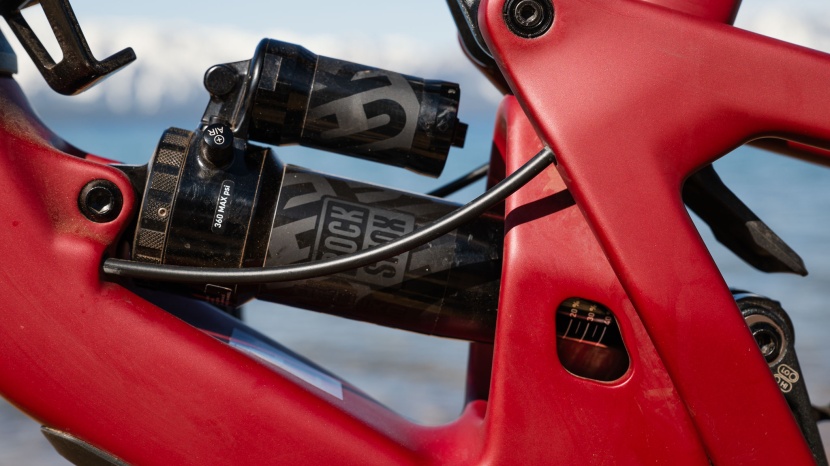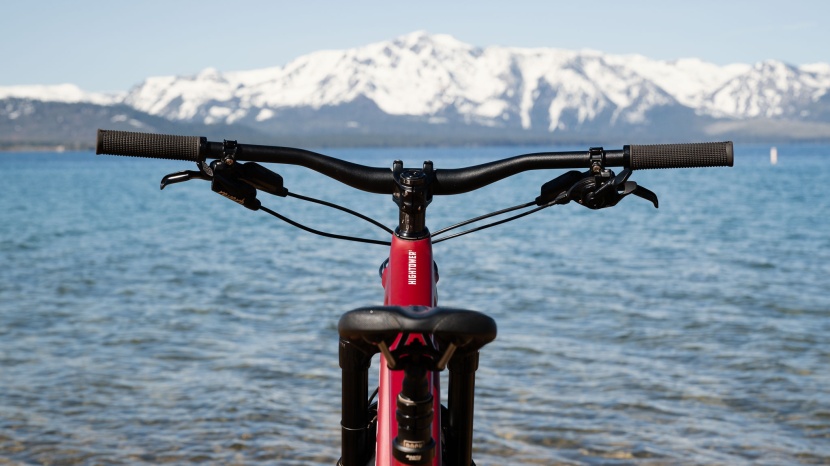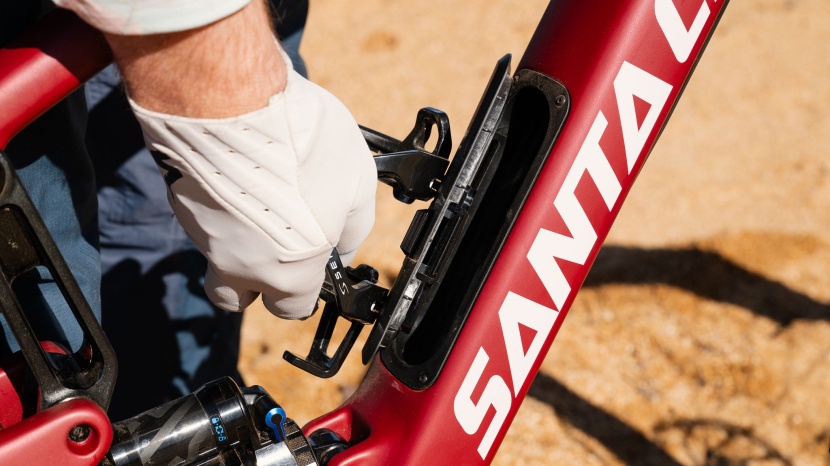
Our Verdict
Our Analysis and Test Results
Should I Buy This Bike?
Your author has been at this gig behind bars since 2017, and as such, this is the 3rd Santa Cruz Hightower I've had the pleasure of testing here at GearLab. Each iteration of this bike has been a hit, and each has made a major contribution to trail bike ride quality. The newest version of this trail brawler packs 145mm of VPP travel, runs a 150mm fork, and is, without a doubt, the most capable Hightower yet. With its big brother, the Megatower, in the lineup, the Hightower sits in a comfortable spot that is capable and resists becoming too inefficient. Santa Cruz's proportional geometry gives each frame size a unique chainstay length and seat tube angle. With reduced anti-squat, this bike has impressive acceleration and outstanding traction.
Skilled riders looking for a hard-charging mid-travel trail bike are bound to have the Hightower on their shortlist. The current VPP bikes are robust trail slayers with a low center of gravity and amazing deep stroke support. Deep stroke support means that deep in this bike's travel, it feels solid and composed; there are a multitude of geometry and engineering reasons that a bike can lose its composure deep in its stroke. Consider how measurements like wheelbase, headtube angle, and bottom bracket height are dynamic through technical riding situations, and you realize that a bike's geometry is so much more than its static numbers. The quick and dirty on this bike; amongst all of the mid-travel trail bikes we've tested, none has the level of stability throughout its travel as the Hightower. That wiggle or squirm of uncertainty that can creep in at the end of a bike's travel just doesn't exist on this platform.
The bike's updated leverage curve kicks up toward the end of the travel, making it less likely that you will bottom out the suspension. As such, it's a great platform for heavier or more aggressive riders that will push its limits. This updated leverage curve should give the bike more small bump compliance, but sensitivity early in the suspension stroke still isn't its forte. The flip-chip in the lower link allows the bike to be ridden high or low; the differences between them are fairly subtle, amounting to 4mm of bb height and .3 degrees of headtube change. In either position, the seat tube angle remains steep enough to give the bike excellent climbing chops, and it never feels floppy or lethargic. The bike conquers steep, chunky terrain without any hint of panic. Few bikes display this level of confidence under duress, and the Hightower always feels like it has your back.
Frame Design
The Hightower 3, as we're calling it to distinguish it from previous iterations, improves on an already fantastic VPP platform. While it's a bit slacker than the outgoing model, most of the geometry changes are pretty mild. The headtube angle moved from 65.2 to 64.5 degrees in the low setting, and the top tube picked up 8mm to compensate. The bike's already steep seat tube angle nudged forward a tenth of a degree, keeping you in the pocket for punchy climbs. The wheelbase gained 12mm thanks to the stats above and the proportional geometry rear end that adds 4mm to our rear center on this size large. All of these changes increase the bike's stability without sacrificing much in terms of agility; it's still a trail bike; it is just leaning toward those enduro capabilities.
The new frame doesn't look much different except for the Glove Box tucked beneath the single water bottle mount on the downtube. Santa Cruz's frame storage is well executed and includes a Tool Wallet and Tube Purse to keep your accessories from rattling around. Opening the glove box involves pushing a small switch on the door; it seems simple enough, but some water bottle cages can complicate access. Like the past Hightower and other Santa Cruz models of this generation, the lower link sits low in the bike, keeping its center of gravity low with the shock piercing the bottom of the seat tube. The lower link features a flip-chip to tweak your geometry, and new for this year, the frame features a Sag Window that makes it easier to check your shocks fun meter. The frame features chainstay and downtube armor, including a shuttle guard to protect your frame when hanging it over a tailgate.
Undoubtedly, some of this bike's stability is due to the amount of frame overlap. It's not the most efficient way to construct a full suspension platform, but the amount of carbon, robust lower linkage, and its proximity to the bottom bracket give the bike a stout feel under power. There are a couple of downsides to having the shock buried so deep in the bike. Being directly in the line of mud and debris from the rear wheel isn't ideal, but a micro-fender extending from the seat tube does an adequate job of protecting it from the big stuff. Accessing the shock's climb switch while you rider isn't exactly easy; reaching down to the shock puts your teeth precariously close to the handlebar.
At just under 7 pounds, the frame isn't light, but the weight is the trade-off for its poise and confidence. Our size large test bike had the carbon fiber C frame that looks identical to the CC model but uses a cost-saving carbon layup that comes with a small weight penalty. Santa Cruz claims that both frames have identical stiffness and performance characteristics. Our complete test bike tipped the scale at 32.5 pounds, which is by no means light, but the weight doesn't have a negative effect on the ride characteristics. The CC frame is said to be about 280 grams lighter in this size.
Design Highlights
- Carbon fiber C (tested), carbon fiber CC available
- Exclusively for 29-inch wheels
- 145mm of VPP suspension
- Sram Universal Derailleur hanger
- Built for a 150mm fork
- Flip-chip adjustable geometry
- Max tire clearance of 2.5"
- Frame offered ala carte in carbon fiber CC for $3,899
- Complete bikes priced from $4,799
Downhill Performance
The Hightower feels refined and efficient enough that it's not out of place on a mellow XC descent, but its alter ego riles up the mosh pit. Seemingly eager to be pointed downhill, this bike comes alive as your speed ramps up, but it remains notably calm; its composure is reassuring. The low bottom bracket and long wheelbase help the bike devour the trail; it plows through rough lines but maintains enough agility to finesse the technical sections. This bike relishes its time deeper in its travel; there's no reason to hold back when pushing this bike's limits. Accelerating out of the corners and stuffing the bike into technical situations, you notice the bike's length. It doesn't feel slow, but it lacks that sporty pop you feel on something like the Bronson. In tight terrain where speeds are lower, the bike is less exciting; it doesn't perform poorly, but it can feel a bit.. bulky.
This current generation of VPP bikes is particularly adept at conquering the big lines. If you want a trail bike that's comfortable when hucked to the site unseen line, there's no better platform to do it on. The RockShox Super Deluxe Select+ gave us a plush, bottomless feel when pushed hard and did an exceptional job keeping the wheel on the ground. There's no languishing in the middle of its travel; getting on the gas was quickly rewarded. Where the suspension feels less impressive is in the little stuff; think of it as not detail-oriented. While it “straight-up handles” the big chunks, it's surprisingly less reactive to the smaller inputs; even when we increased the sag to 35%, we felt the small bump compliance wasn't this bike's superpower. If you're a more finessed rider, you can use this to your advantage; you pick clean lines, absorb the small bumps, and leave the big jobs to the bike. High-frequency bumps can feel a bit more exhausting on this bike, especially in the latter half of a ride.
We purchased the C frame with an S build, one notch up from the least expensive. The Fox 36 Performance lacks dampening adjustments that let you really tune the front end, but for the most part, its chassis and ride characteristics compliment the bike well. A RockShox Super Deluxe Select+ handles the rear suspension, and while it similarly lacks fancy dampening capabilities, its performance is admirable, and many riders won't fully appreciate independent low and high-speed compression dampening adjustments anyway. If you're someone who enjoys tuning separate dampening adjustments, step up to the Super Deluxe Ultimate that comes on the XO AXS build. SRAM Code R dual-piston brakes squeezing 180mm Centerline rotors give the bike plenty of stopping power. A solid Burgtec cockpit was more comfortable than we expected, and the alloy 800mm RideWide handlebar provided a noticeable amount of flexibility. The Hightower relies on 2.4" Maxxis Minion tires for its earthly connection. The MaxxGrip front tire provides a little extra hold, which is great on slick rock and hard surfaces. While the 2.4" casing feels fast and precise, the front tire was more inclined to dig into sandy and soft soil, especially when making aggressive moves; hard-charging riders might opt for a bit more rubber.
DT Swiss 370 hubs laced up to RaceFace AR rims performed as expected; in extreme circumstances, a bit of flex from the front wheel felt unwelcome. The wheels feel totally appropriate at this price point, but large gains in comfort, performance, and handling are possible with upgraded wheels. One of the things we appreciate about the newer generation of 370 hubs is their compatibility with upgraded ratchets. This lets you install a simple pair of ratchet rings in the rear hub and increase their engagement speed; it's a cost-effective upgrade. We also rode this bike with a pair of Zipp 3Zero Moto wheels, and the performance difference was astonishing. While we didn't feel like the stock wheels were necessarily lacking, the single-walled carbon hoops and high-quality hubs made an enormous difference in the bike's responsiveness and compliance.
Uphill Performance
We've become accustomed to how well these modern-trail geometry bikes can climb, and the Hightower is no exception. It's almost startling that this climbing performance and descending performance can be coupled in a single bike. You don't expect this long, slack sled to rocket you uphill, but that's exactly what happens. Santa Cruz pushed the seat tube up to 76.7 degrees (size large in high setting) and gave the Hightower proportional geometry so each size has a unique rear center and appropriate seat tube angle for its size. It's not all roses on the way up, as the bike's added length makes it less nimble and tougher to maneuver in technical situations. Still, it likely climbs faster and more efficiently than lightweight XC bikes from just a few years prior.
The Hightower is also a solid chunk of carbon and alloy weighing in at 32.5 pounds. Despite the steeper seat tube angle, the bike feels roomy thanks to its long 475mm reach, and we found long climbs to be exceptionally comfortable. The long 1245mm wheelbase announces itself in tight turns or low-speed directional changes. There is no wandering in the front end, and it plays well with technical up-and-over moves. We messed with the flip-chip a few times and found we preferred the low setting, even if it put our pedals at a higher risk of pedal strikes. We appreciated the slightly lower center of gravity and stance it provided. In the high setting, we liked how the steering quickened up but not enough to sacrifice the lower bb.
The VPP suspension platform is renowned for its supportive nature. Chain tension restricts the suspension's initial movement and keeps the bike fairly spry on the climbs. Under constant power, there is no detectable bob or unwanted suspension movement. We toyed with the shock's climb switch, but outside of an hour-long paved climb to earn something special, we didn't find it all that useful. In many ways, that's a compliment to the bike's kinematics; the shock is also hard to reach, so we're happy to keep our hands on the bars. The way this bike climbs is going to impress anyone who hasn't been on a new mountain bike in the past few years. If you're more current with your comparisons to other offerings, the bike feels less eager than some of the DW-link, CBF, or 4-bar designs, but it's no slacker.
The bike has a respectable build kit that doesn't distract from the bike's overall quality. If we were to pick a low point of the build, it's the wheels. The RaceFace rims are built to DT Swiss 370 hubs, and while you can upgrade the ratchet mechanism in the rear wheel for faster engagement, you can't increase the stiffness of these wheels. We're admittedly spoiled from riding carbon wheels, but the flex in the front wheel felt detrimental to the bike's performance at times. The SRAM GX Eagle drivetrain provided excellent range and performed as expected, but it feels less impressive since the introduction of SRAM's Transmission. If you've decided this is the bike for you and are vacillating between build kits, we'd recommend the GX AXS Reserve build with SRAM's Transmission drivetrain and Santa Cruz Reserve wheels. The drivetrain and wheels have made lasting, positive impressions on us while testing other bikes and would give this bike a no-compromises feel. Maxxis Minion rubber feels just about the standard in this category, and for a good reason: they are excellent tires with tremendous grip. The front tire is a 2.4" MaxxGrip EXO casing that feels precise and hooks up well, but aggressive riders or those riding softer conditions will benefit from a bit more width.
Photo Tour
Value
The Carbon C S build we tested was listed for $5899, which isn't cheap but seems to have been permanently reduced to $5099. The R build can be had for $4799 and doesn't come with a significant drop in performance. An Ala carte frame sells for $3899 but is only available in the more expensive (and lighter) CC carbon. The CC frame is available with Santa Cruz's top-end build and Reserve wheels for $10,899. The price of the bike we tested seems to be on the higher end, given its component specs. While riding this bike, I encountered some riders on a few other generations of the same bike, and one of them said, “You know, this is the Toyota Tacoma of mountain bikes.” He went on to explain how they seem more expensive than they should be, have solid performance, are highly desirable, and hold their resale value well. Hmmm..
Conclusion
Aggressive trail riders will absolutely love the newest Hightower 3. The recent tweaks to the geometry have given this rig even more confidence to crush the hard lines. The 150mm fork keeps it in that trail-bike category, but we'd absolutely ride this as an enduro bike with a 160mm fork up front. Deep stroke stability is the main hallmark of this platform; it's impressively stable at speed and inspires confidence in steep and rowdy terrain. The bike's longer wheelbase is a bit much in tight and technical terrain, a tradeoff for its confident and composed performance when things get gnarly.
















